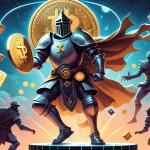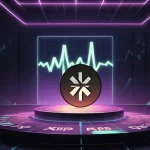Epic Chain, Backed by Ripple, Launches XRP Platform to Tokenize $50T in Real-World Assets

Ripple-Backed Epic Chain Launches XRP-Powered Platform to Tokenize Real-World Assets
A new heavyweight contender has entered the blockchain ring. Epic Chain, with Ripple’s muscle behind it, is rolling out an XRP-native platform designed to tokenize real-world assets (RWAs)—think real estate, credit, commodities, and even collectibles. This ambitious project aims to carve out a piece of a jaw-dropping $50 trillion market, dragging clunky, off-chain assets into the decentralized future with speed and scalability. But can it deliver, or is this just another crypto pipe dream?
- Epic Chain’s Goal: Tokenize real-world assets using XRP for seamless on-chain movement.
- Market Opportunity: Targets a $50 trillion RWA market with Ripple’s fast, low-cost infrastructure.
- Potential Pitfalls: Faces risks from past pivots and XRP’s slower corporate pace.
What Is Epic Chain, and Why XRP?
Epic Chain is a blockchain project backed by Ripple, a company long focused on enterprise-grade financial solutions. The platform leverages XRP, Ripple’s native cryptocurrency, to tokenize real-world assets—converting ownership of physical or financial assets into digital tokens on a blockchain. These tokens can be traded, split into fractions, or transferred globally with minimal friction. Imagine owning a sliver of a skyscraper for $100, or trading a piece of a rare painting like you would a stock, all without the middlemen or hefty fees of traditional finance. That’s the vision Epic Chain is chasing with Ripple’s support.
XRP brings distinct advantages to the table. The XRP Ledger, the blockchain powering this ecosystem, is known for settlement times of 3-5 seconds and transaction costs that are mere fractions of a cent. Compare that to Bitcoin’s 10-minute confirmations or Ethereum’s often painful gas fees, and you see why Epic Chain opted for this infrastructure. It’s a system built for high-volume, institutional-grade use cases—perfect for moving billions, or even trillions, in tokenized assets without breaking a sweat.
Unpacking Real-World Asset Tokenization
Let’s break down RWA tokenization for those new to the game. It’s the process of representing ownership of tangible or financial assets—real estate, commodities like gold, credit instruments, or even collectibles—as digital tokens on a blockchain. Each token acts as a digital deed, verifiable and tradeable in ways traditional assets often aren’t. For example, a $10 million property could be split into 10,000 tokens, allowing small investors from anywhere in the world to buy in for as little as $1,000. This isn’t just about convenience; it’s about liquidity, accessibility, and tearing down the barriers of legacy finance. Curious about the broader implications? Check out this discussion on RWA tokenization with XRP.
The implications are massive. Tokenization could unlock markets previously reserved for the ultra-wealthy or institutional players, democratizing wealth-building in a way that aligns with the ethos of decentralization. It also streamlines transactions, cutting out bloated intermediaries like banks or brokers who thrive on inefficiency. With a market potential exceeding $50 trillion, as estimated by industry projections, Epic Chain is positioning itself at the forefront of this financial revolution.
Tech Under the Hood: XRP Ledger and Beyond
Epic Chain isn’t just riding Ripple’s coattails—it’s integrating deeply with the XRP Ledger’s capabilities. Initially launched as an ERC-20 token on Ethereum, the project is migrating to an EVM-compatible sidechain of the XRP Ledger. For the uninitiated, a sidechain is like a secondary road built alongside a main highway—it handles specific traffic (like tokenization workloads) more efficiently while staying connected to the primary network (XRP Ledger). EVM compatibility means developers can build smart contracts—self-executing agreements that automatically process transactions when conditions are met—using tools familiar from Ethereum, blending scalability with accessibility. Learn more about this framework through the Epic Chain RWA tokenization overview.
Another key piece is Ripple USD (RLUSD), a stablecoin pegged to the US dollar. This integration allows native USD settlement on the platform, a critical feature for institutional players managing yields, treasury operations, or cross-border payments. Imagine a hedge fund settling a $10 million real estate token deal in seconds, without the volatility of crypto prices or the delays of wire transfers. That’s the kind of efficiency Epic Chain is banking on to woo big money.
A $228 Trillion Dream: RealFi and Real Estate Tokenization
Now, let’s talk numbers that sound almost absurd. Through a partnership with RealFi, the XRP Ledger Asset Program, launching on August 18th, aims to tokenize $228 trillion in institutional real estate via the REAL Token initiative. Yes, trillion with a ‘T’—a figure larger than the combined GDP of every nation on Earth. RealFi’s pitch is compelling: using the XRP Ledger, they can offer near-instant settlement and transaction fees so low they’re practically negligible, transforming a notoriously illiquid market into something far more dynamic. For a deeper fact-check on this ambitious goal, take a look at this analysis of RealFi’s real estate tokenization plans.
But let’s ground this in reality. The current tokenized asset market, including real estate, is valued at less than $1 billion globally. Even optimistic projections suggest a $16 trillion market by 2030 if every star aligns. So, while $228 trillion represents the theoretical total value of institutional real estate worldwide, achieving even a fraction of that on-chain is a decades-long slog, not a next-year milestone. Regulatory mazes, adoption hurdles, and plain old inertia in traditional finance will slow this down. Still, the ambition signals a seismic shift—if blockchain can crack open even 1% of that market, it’s a game-changer for global finance.
Appealing to All: Retail Perks and Institutional Tools
Epic Chain isn’t just courting Wall Street; it’s got something for the everyday crypto user too. The “Epic One” VISA crypto card offers up to 8% cashback in XRP and is usable in over 180 countries—pretty slick for buying a latte with crypto gains. Then there’s Fanable, a collectibles platform with licensed IP deals, tapping into the NFT and nostalgia crowd. Whether you’re a degen chasing digital trading cards or a casual user wanting crypto rewards, there’s a hook here.
For institutional players, the focus is on serious financial plumbing. Beyond RWA tokenization, integration with RLUSD enables USD-denominated settlements for treasury management or cross-border transactions. Add in a $1 million adoption program to drive global liquidity, operations in over 150 countries, and ties to more than 1 million bank accounts, and you’ve got a platform targeting 100 million traders with both Main Street and Wall Street in mind. Currently valued at a $60 million fully diluted valuation and trading on exchanges like Binance, Bybit, and Kucoin, Epic Chain is making bold moves to capture attention across the board. For more on similar initiatives, explore Ripple’s RWA tokenization projects.
Risks and Roadblocks: No Rose-Colored Glasses Here
Before we get swept away by trillion-dollar fantasies, let’s talk cold, hard risks. Epic Chain has a history of strategic pivots—shifting focus from one niche to another—which could be seen as adaptability or a glaring lack of vision. In a space littered with failed projects and outright scams, that kind of track record raises eyebrows. Investors might wonder if this is a team that can execute or just one chasing the latest hype cycle. For a historical perspective on these shifts, dive into this comparison of Epic Chain’s pivots against competitors like Ethereum and Solana.
Then there’s XRP itself. Despite Ripple’s clout in enterprise blockchain, its corporate momentum often feels glacial compared to the frenetic pace of ecosystems like Ethereum or Solana. Ethereum’s DeFi boom, fueled by a sprawling developer community, dwarfs XRP’s more measured, institutional approach. And while we’re not diving deep into Ripple’s legal battle with the U.S. SEC over whether XRP is a security, suffice it to say an unfavorable ruling could ripple—pun intended—through projects like Epic Chain, spooking investors or slowing adoption.
Regulatory hurdles are another beast. Tokenizing assets across 150+ countries means navigating a patchwork of laws on property rights, securities, and anti-money laundering (AML) compliance. In the U.S., the SEC could classify tokenized assets as securities, triggering a cascade of red tape. In Europe, strict KYC rules might choke off retail access. And in emerging markets, outright bans on crypto could derail entire regions. This isn’t a hypothetical—past tokenization efforts have hit walls when regulators stepped in. Epic Chain and Ripple will need airtight compliance strategies to avoid becoming a cautionary tale.
Competition in the RWA Space
Epic Chain isn’t the only player eyeing the RWA goldmine. Ethereum hosts tokenized treasuries and platforms like BlackRock’s BUIDL, leveraging its massive developer ecosystem and first-mover advantage. Polygon offers scalable solutions for asset tokenization with lower costs than Ethereum’s mainnet. Even Solana, with its blazing speed, is dipping toes into this space. XRP’s edge lies in transaction speed and cost—settling deals faster than you can say “smart contract”—but it lacks the vibrant, decentralized innovation hubs of its rivals. Can Epic Chain carve out a niche, or will it get lost in the noise of more agile competitors?
From a Bitcoin maximalist lens, I’ll throw in a curveball: could Bitcoin, the king of crypto, play a role in RWA? Unlikely for direct tokenization due to its slower settlement and focus as a store of value, but perhaps as collateral or a final settlement layer on platforms like Lightning Network. For now, XRP’s utility focus fits this niche better, but Bitcoin’s gravitational pull in the crypto world means it’s never entirely out of the conversation.
Security in Crypto’s Wild West
Let’s not sugarcoat it—crypto remains a lawless frontier. Recent data shows phishing scams alone siphoned off $5.32 million from over 7,000 victims in a single month this year. Platforms like Epic Chain, especially with retail-friendly tools like crypto cards and collectibles, are prime targets for hackers and scammers. A single exploit could tank user trust faster than a bear market. For community insights on related XRP projects, check out this Reddit thread discussing Epic Chain and Ripple.
Epic Chain must prioritize security—think multi-signature wallets (requiring multiple keys to authorize transactions), hardware wallet support, and transaction simulators to spot shady activity. User education is just as critical; too many fall for phishing links out of ignorance or FOMO. If Epic Chain doesn’t build an ironclad fortress around its users, it’s not just risking funds—it’s risking its entire reputation. And in crypto, reputation is everything.
Key Takeaways and Questions to Ponder
- What is real-world asset (RWA) tokenization, and why does it matter?
It’s the process of turning ownership of physical or financial assets into digital tokens on a blockchain, enabling fractional ownership and global trade. It matters because it could democratize access to trillions in value, disrupting traditional finance with liquidity and efficiency. - How does XRP give Epic Chain a competitive edge?
XRP and the XRP Ledger offer lightning-fast settlements (3-5 seconds) and negligible fees, ideal for high-volume institutional use cases like RWA tokenization, compared to slower or costlier networks like Bitcoin or Ethereum. - Is the $228 trillion real estate tokenization goal achievable?
Not in the near term—it’s a long-term vision, far beyond the current tokenized market of under $1 billion. Regulatory, technical, and adoption barriers make this a decades-long journey at best. - What are the biggest risks facing Epic Chain?
Past strategic pivots suggest instability, XRP’s slower corporate momentum lags behind rivals, and Ripple’s SEC legal battle could cast a shadow over investor confidence and adoption. - How does Epic Chain balance retail and institutional appeal?
Retail users get perks like the “Epic One” VISA card with XRP cashback and the Fanable collectibles platform, while institutions gain RWA tokenization, RLUSD for settlements, and treasury management tools.
Weighing the Future
Epic Chain, with Ripple’s backing, is swinging for the fences, aiming to redefine asset ownership with blockchain tech. The potential to tokenize even a sliver of a $50 trillion RWA market—or a fraction of that $228 trillion real estate dream—could cement blockchain as a cornerstone of global finance. XRP’s speed and cost advantages, paired with tools for both retail and institutional players, make this a project worth watching.
But the road is treacherous. Strategic missteps, regulatory quagmires, cutthroat competition, and the ever-present threat of scams loom large. Execution will be everything—if Epic Chain stumbles, it risks becoming another overhyped crypto footnote. Yet, if it succeeds, we might witness a leap toward financial freedom and decentralization that even the staunchest Bitcoin maximalists can’t ignore. Trillions are on the table, and that’s a stakes game no one can afford to sleep on.



